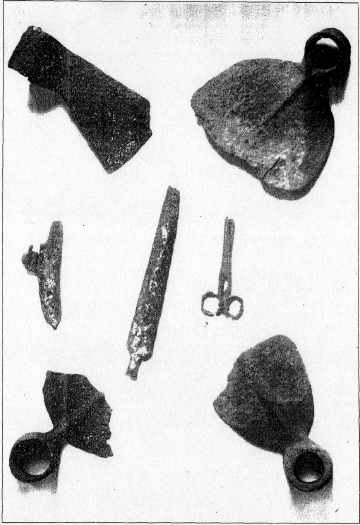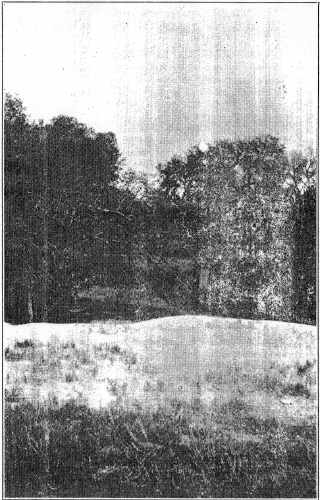
NEGenWeb Project
On-Line Library

Recent iron implements found on Republican Pawnee
Village Site. Webster County, Nebr.
251
NEBRASKA HISTORY MAGAZINE |
251 |
line; but it tallies to a mile--that, on the 25th day of September, his party did reach the spot which the state of Kansas has marked; and where there is every evidence that it is the site of the Pawnee Republic capital Pike describes.
It is only fair to Doctor Coues to mention that several years after his work was published, he admitted his error in tracing Pike too far north and up into Nebraska, and came to the conclusion that the Kansas site, as marked in 1901, was the place where Pike met and treated with the Pawnees. To correct this error, he wrote to B. D. Haney, of Courtland, and Gomer Davies, of Concordia, to that effect, and those letters should be annotated in his volumes in our library, in order that students of history of this matter might not be misled. We submit the letters herewith:
Smithsonian Institution, Washington, D. C.,
March 1, 1896.
Gomer T. Davies, Secretary Pawnee Historical Society:
Dear Sir--I acknowledge with pleasure the reception
of your interesting letter of February 21, relating to the supposed location
of the Pike camp of 1806, and to the good progress made by your society in promoting
historical research. You already know the great interest I take in the matter;
Indeed, I shall consider it fortunate, rather than otherwise, if my own leaving
of the location of the Pawnee village open in my book leads to such active endeavor
and fruitful results as those of your society. At present I see no reason to
doubt that you have the right of it, and that, when you have fully formulated
your results, there will remain no question of the exact location of the Pawnee
village or of Pike's memorable camp. You will see by the large map which I sent,
and which, I believe, Is now in Mrs. Johnson's hands, that I trailed Pike directly
to White Rock; and all your present research confirms the impressions I formed
at the time, though I did not venture to commit myself to final conclusions.
The doubts a my own work which then arose in my mind was mainly due to the Gregg
map of 1844, which puts the Pawnee village near Webster City, Neb. But I am
now satisfied that this Is an error. With regard, very truly yours.
ELLIOTT COUES.
Letters from Doctor Coues to Mrs. George Johnson and B. D. Haney are quite as frank and as ready to accept the correction of the error of location into which he was led by the Gregg map.
B. D. Haney, of Courtland, received the following letter from Mr. Coues, dated Washington, D. C., January 18, 1896:
7
| 252 | NEBRASKA HISTORY MAGAZINE |
"I congratulate you on the organization of the Pawnee Republic Historical Society, which I am glad to see includes the ladies, and which I have no doubt will do good work. I should judge you are quite right in claiming the site of Pike's Pawnee village at the bluffs on the Republican river opposite Republic City, a little below the mouth of White Rock creek.
"I had trailed Pike exactly to the site of the present village of White Rock, but then became a little undecided in my mind, on account of the alleged position of the village on Gregg's map of 1844. I ought to have had more confidence in my own judgment. Gregg's positions is far out of the way, as I now see. So is Scandia, which has also been claimed as the right place. I have no doubt your society has the right of it.
"I send you by same mail with this a map on a large scale, showing all the topographical details very clearly. Please do not fold it or let it get soiled, and return it after you have laid it before the society. Please stick a pin in the precise spot of the Pawnee Republic. I have marked where I suppose it to be, and also Pike's camps of September 23 and 24. Where do you suppose Pike was camped between September 25 and October 7? It was not exactly at Pawnee village, and I think a little further north.
"What you say of the old Pawnee trail to Buffalo creek is interesting. The distance, 'eighteen miles,' is just about right. But now please inform me exactly where this old trail struck Buffalo creek. Was it nearest to Jamestown, or Randall, or Jewell? You will find me speaking of this old trail on page 420 of my book, and fetching there to Buffalo creek, but I did not know exactly where the trail crossed the creek."
Doctor Coues unfortunately took Gregg's map as an authority upon a matter of which Gregg had no knowledge. This map is found in the work entitled "Commerce of the Prairies, or the Journal of a Santa Fe Indian trader during eight expeditions across the great Western Prairies, and a residence of nearly nine years in Northern Mexico, illustrated with maps and engravings, by Josiah Gregg, 1844." His map covers the general western country from the Missouri to the great divides of the Rockies, and from the Platte river to the center of Texas. In none of his writings does he say he was ever on the Republican river.
Gregg is an authority upon the Santa Fe trail and the Southwest, over which he passed many times, and was interested in the Santa Fe trail trade and that region it served; but when he gets away from its environments, his map is filled with errors, which Doctor Coues discovered after he, Coues, had edited Pike's Journal. It is fortunate that Doctor Coues lived to correct his error in depending upon Gregg's map to follow Pike in his travels.

Where Pike found the Pawnee camp, Oct. 9, 1806 within
the Grand or Solomon fork.'' Photo by A. E. Sheldon, 1924.
253
NEBRASKA HISTORY MAGAZINE |
253 |
The site of this Pawnee Republic Indian town will always be one of the Interesting historical shrines of Kansas, and our Society must have a fine collection of its relics, which have been and can be found in that neighborhood.
IN CONCLUSION
No fair person can read Pike's account of his approach to, his experiences in, and his description of the Pawnee Republic village, then fully examine the ruins and environments of the Kansas site, and not come to the conclusion that Kansas and the State Historical Society marked the right place.
Here we find the numerous foundation circles of those large ground-house lodges, just as he described them. We can easily trace the fortification embankment and the extent of a very large and ancient Indian village. We note that a considerable portion of it has been obliterated by the plow, except to those trained in investigating such places. We find that during the years numerous relics have been turned up, such as iron hoes, copper kettles, Spanish bridle bits, broken stone mills, flints and unfinished flint material, pipestone pipes-some unfinished--fragments of pottery, hammer-stones and mauls, parts of old guns, tomahawks, bits of copper and copper arrow points, Indian beads and buttons, and all kinds of articles and artifacts found upon the site of a populous and long-occupied Indian town.
Much charred corn has been uncovered, which proves the town was once burned by enemies and well supplied with food. There is a large cemetery which has been hardly touched. The graves are about five feet deep and the burials were orderly. From all this, and the actual Indian corn fields discovered, it is certain that the Pawned women were industrious and produced much corn and other crops, as Pike described; and that these Indians had advanced along a higher plane than many tribes had reached.
Beyond any doubt, it was the place Lieutenant Pike visited them from September 25 to October 7, 1806, and from which they fled, when destroyed fully twenty years afterwards, and occupied that Pawnee townsite west of Guide Rock, Neb.--the place where they were all but exterminated by smallpox.
The scenes of that scourge, which visited them in the thirties, are indescribable. They died by hundreds and thousands, like the passing of flies in frost time. Many would foolishly sweat themselves and then jump into the cold waters of the river and
| 254 | NEBRASKA HISTORY MAGAZINE |
never survive the shock. Their bodies were found upon the sand banks, in the shallow waters, along the river, in the bushes and grassy ravines, everywhere, and were not always interred. Only by wholesale vaccination were any of the tribe saved. Truly, in the sad words of the "Indian's Lament"
"Like the shadows of the streams,
Like the evanescent gleam
Of the twilight's failing blaze,
Like the fleeting years and days,
Like all things that soon decay,
Pass the Indian tribes away.
* * * * * * *
To his day there'll dawn no morrow;
Therefore is he full of sorrow."To our entire country, but especially to Kansas, there will always be a halo of historic glory and romance around the name of Zebulon Montgomery Pike. He was a brave and resourceful military leader, hero, patriot, explorer and diplomat. He was the first American who traversed the length and breadth of what afterwards became the Sunflower state, and who described its rivers, valleys, and plains--its geology, flora and fauna.
It Is well that the state of Kansas has honored his memory by erecting a monument and inclosing a part of the site of that great Pawnee Republic Indian capital, where he enacted that historic flag espisode (sic) six score of years ago. However, the tract of ground upon which the monument stands, and its iron in closure, should be more carefully protected from desecration and destruction; for iit is one of our most sacred shrines, and will increase in importance and value as the years go by. In that the Kansas State Historical Society is given, by law, "the care and control of the premises," it should be vigilant as the trustee for the state and as the custodian of that noted spot.
"Though sluggards deem it but a foolish chase,
And marvel men should quit the easy chair,
The weary way and long, long league to trace;
Oh! there is sweetness in the prairie air,
And life that bloated ease can never hope to share."GEO. P. MOREHOUSE, Chairman,
Archaeological and Indian Committee.Of the committee--
MARK E. ZIMMERMAN,
EDWARD PARK,
E. D. HANEY.
© 2004 for the NEGenWeb Project by Ted & Carole Miller